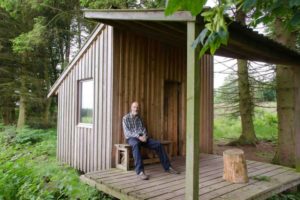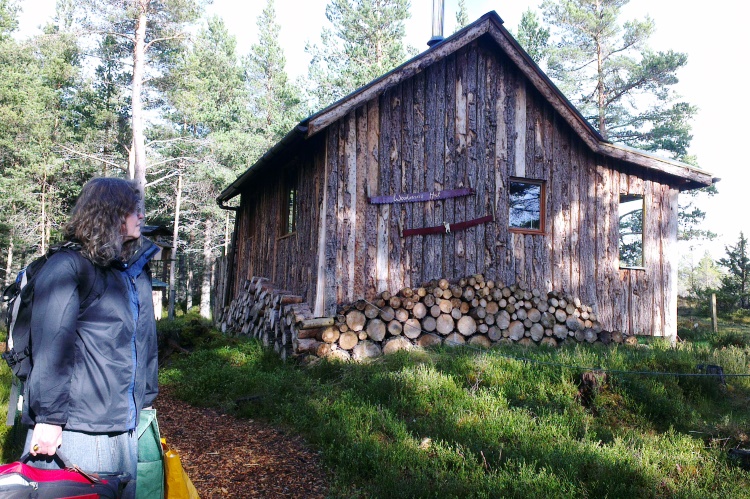Love huts (FWN 29)
25 September 2017In Scandinavian countries, many families have a summer house, which in reality is a wooden cabin or hut in the woods they retreat to at weekends or for holidays.
In Sweden alone, there are over 600,000 summer houses and more than 50% of the population have access to one through family or friends. It’s a strong tradition that has continued for generations, with the summer house being passed down the family from one generation to the next. Being surrounded by nature, working with one’s hands, completing simple tasks for the sake of just living from one day to the next, is an antidote to the high-paced artificial lives we live.
Huts and hutting, as it’s known in Scotland, has been around since the first world war, when the Carbeth hut community was set up to accommodate returning soldiers in a peaceful environment. This and other hut communities grew over the following years near industrial cities as they offered cheap holiday accommodation for low-income families, peaking in the 1940s as emergency accommodation during world war two bombing of the industrial cities. Traditionally the hutter owns the hut and pays a lease to the landowner for the use of the land.
In recent years however there has been a growing interest in hutting. For the past 25 years the charity Reforesting Scotland has campaigned for a ‘sustainable forest culture in Scotland’, part of which was the launch of the campaign A Thousand Huts, in 2011. The aim of this campaign is ‘to promote huts and hutting – the building and enjoyment of simple structures (usually wooden) for living, working and recreation in the countryside’. The campaign took a major leap forward in 2014 when the Scottish Government recognised and included huts in Scottish planning policy. Until then there had been no definition of a hut, which proved to be a barrier to seeking permission to build one. The development of huts is seen as another way of stimulating the rural economy.
The whole ethos of hutting is centred on low impact, and this is reflected in the Scottish Government’s definition of a hut:
‘A simple building used intermittently as recreational accommodation (i.e. not a principal residence); having an internal floor area of no more than 30m2; constructed from low impact materials; generally not connected to mains water, electricity or sewerage; and built in such a way that it is removable with little or no trace at the end of its life. Huts may be built singly or in groups.’
Following this definition, huts should be established on the following basis:
- Design, materials, construction, waste management and access should all be ecologically sustainable;
- Hut sites should be carefully chosen, avoiding those sites which are not suited to them;
- Decision-making should include the local community to ensure community cohesion;
- ‘Robust and equitable tenancy agreements giving clarity to tenant hutters and landowners’;
- Safeguards to prevent hut sites being further developed, with greater impacts, in the future.
Huts do require planning permission. But further recent developments in legislation (as of July 2017, and the result of public consultation) mean that building regulations for huts have been relaxed, making it easier and cheaper to build them. Scottish Government have created a new building type especially for hutting, which exempts huts from many building regulations; those regulations which must be followed (relating to structure, stoves, barriers) will not need a building a warrant but are still required by law to be followed. A building warrant is required for underground drainage, or if limitations are exceeded (eg. floor area, minimum distance to other buildings).
The Thousand Huts webpage contains everything you need to know to get started.
Groups of huts are permitted, traditionally these have been up to 12 but usually far fewer. The number of huts at the Carbeth site (approx. 140) is unusual and would not be permitted under the current planning arrangements.
It is important to note when a hut is not a hut. Huts do NOT include fishing huts, climbing huts or bothies (due to their different use), shipping containers, caravans, portacabins, buildings made with breezeblocks etc, or holiday chalets (because they are fully serviced).
One of the main premises of hutting is its affordability. The construction of huts is based on low cost and low impact, with the land on which it sits being rented. And this is perhaps the single most important aspect that must be considered right at the outset, by both landowner and hutter. History shows that informal agreements between the two parties have often ended in disappointment, typically because a landowner has sold the land and the hutter then finds they have no legal right to their hut. This can be avoided by making a mutually agreed formal contract between both parties, for which you should seek expert advice. In summary, this should include:
- Lease period;
- Terms of lease;
- Notice periods;
- Who holds the rights to the hut during the lease period, and what happens to the land/hut and rights to each if the land or hut is sold.
The vast majority of hutters have a keen interest in the environment and their hut’s surroundings. Part of an agreement may, therefore, include some aspect on woodland management, extending some way beyond the hut itself, providing firewood for the hutter (and perhaps the landowner) and low-impact management of what may be an otherwise non-viable wood in commercial management terms.
So why would you allow a hut development on your land? Additional income from the lease, low-impact management of your woods, spending in the local economy. And what should you look out for? Make sure you’re satisfied with the character of the prospective hutters, and the location and design of the proposed hut. But most of all, make sure that you have a mutually agreed, formal tenancy contract in place.
More information can be found at www.thousandhuts.org
Malcolm Young, SAC Consulting
Donald McPhillimy, Reforesting Scotland’s Thousand Huts campaign
Sign up to the FAS newsletter
Receive updates on news, events and publications from Scotland’s Farm Advisory Service

